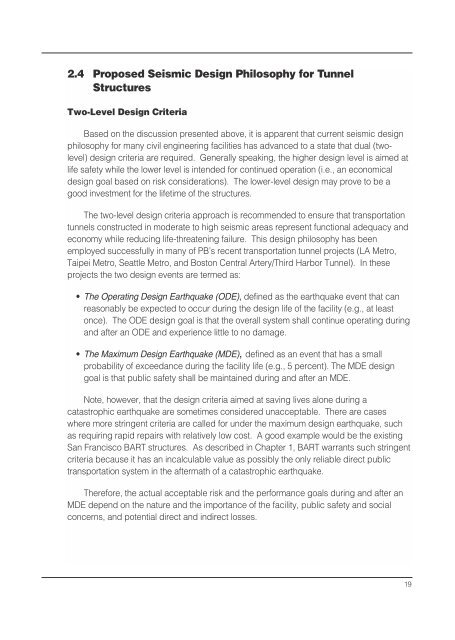Seismic Design of Tunnels - Parsons Brinckerhoff
Seismic Design of Tunnels - Parsons Brinckerhoff
Seismic Design of Tunnels - Parsons Brinckerhoff
Create successful ePaper yourself
Turn your PDF publications into a flip-book with our unique Google optimized e-Paper software.
2.4 Proposed <strong>Seismic</strong> <strong>Design</strong> Philosophy for Tunnel<br />
Structures<br />
Two-Level <strong>Design</strong> Criteria<br />
Based on the discussion presented above, it is apparent that current seismic design<br />
philosophy for many civil engineering facilities has advanced to a state that dual (twolevel)<br />
design criteria are required. Generally speaking, the higher design level is aimed at<br />
life safety while the lower level is intended for continued operation (i.e., an economical<br />
design goal based on risk considerations). The lower-level design may prove to be a<br />
good investment for the lifetime <strong>of</strong> the structures.<br />
The two-level design criteria approach is recommended to ensure that transportation<br />
tunnels constructed in moderate to high seismic areas represent functional adequacy and<br />
economy while reducing life-threatening failure. This design philosophy has been<br />
employed successfully in many <strong>of</strong> PB’s recent transportation tunnel projects (LA Metro,<br />
Taipei Metro, Seattle Metro, and Boston Central Artery/Third Harbor Tunnel). In these<br />
projects the two design events are termed as:<br />
• The Operating <strong>Design</strong> Earthquake (ODE), defined as the earthquake event that can<br />
reasonably be expected to occur during the design life <strong>of</strong> the facility (e.g., at least<br />
once). The ODE design goal is that the overall system shall continue operating during<br />
and after an ODE and experience little to no damage.<br />
• The Maximum <strong>Design</strong> Earthquake (MDE), defined as an event that has a small<br />
probability <strong>of</strong> exceedance during the facility life (e.g., 5 percent). The MDE design<br />
goal is that public safety shall be maintained during and after an MDE.<br />
Note, however, that the design criteria aimed at saving lives alone during a<br />
catastrophic earthquake are sometimes considered unacceptable. There are cases<br />
where more stringent criteria are called for under the maximum design earthquake, such<br />
as requiring rapid repairs with relatively low cost. A good example would be the existing<br />
San Francisco BART structures. As described in Chapter 1, BART warrants such stringent<br />
criteria because it has an incalculable value as possibly the only reliable direct public<br />
transportation system in the aftermath <strong>of</strong> a catastrophic earthquake.<br />
Therefore, the actual acceptable risk and the performance goals during and after an<br />
MDE depend on the nature and the importance <strong>of</strong> the facility, public safety and social<br />
concerns, and potential direct and indirect losses.<br />
19
















